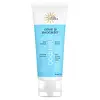What's inside
What's inside
 Benefits
Benefits

 Concerns
Concerns

 Ingredients Side-by-side
Ingredients Side-by-side

Water
Skin ConditioningSodium Cocoyl Isethionate
CleansingCocamidopropyl Betaine
CleansingSodium Methyl Cocoyl Taurate
CleansingCocamidopropyl Hydroxysultaine
CleansingGlycerin
HumectantArgania Spinosa Kernel Oil
EmollientButyrospermum Parkii Butter
Skin ConditioningCocos Nucifera Oil
MaskingAloe Barbadensis Leaf Juice
Skin ConditioningHydrolyzed Silk
HumectantPersea Gratissima Oil
Skin ConditioningOlea Europaea Fruit Oil
MaskingGlyceryl Caprylate
EmollientGlyceryl Undecylenate
EmollientGlycol Distearate
EmollientPotassium Sorbate
PreservativeHydroxyethylcellulose
Emulsion StabilisingCitric Acid
BufferingParfum
MaskingWater, Sodium Cocoyl Isethionate, Cocamidopropyl Betaine, Sodium Methyl Cocoyl Taurate, Cocamidopropyl Hydroxysultaine, Glycerin, Argania Spinosa Kernel Oil, Butyrospermum Parkii Butter, Cocos Nucifera Oil, Aloe Barbadensis Leaf Juice, Hydrolyzed Silk, Persea Gratissima Oil, Olea Europaea Fruit Oil, Glyceryl Caprylate, Glyceryl Undecylenate, Glycol Distearate, Potassium Sorbate, Hydroxyethylcellulose, Citric Acid, Parfum
Water
Skin ConditioningSodium Cocoyl Isethionate
CleansingCocamidopropyl Hydroxysultaine
CleansingSodium Cocoyl Methyl Isethionate
Glycerin
HumectantCitrus Paradisi Peel Oil
MaskingSodium Chloride
MaskingGlycol Distearate
EmollientPanthenol
Skin ConditioningCoconut Acid
CleansingDecyl Glucoside
CleansingSodium Methyl Cocoyl Taurate
CleansingGlyceryl Caprylate
EmollientHydroxypropyl Guar Hydroxypropyltrimonium Chloride
Sodium Isethionate
CleansingDisodium Cocoyl Glutamate
CleansingTetrasodium Glutamate Diacetate
Sclerocarya Birrea Seed Oil
HumectantXimenia Americana Seed Oil
EmollientCaprylhydroxamic Acid
Citric Acid
BufferingSodium Hydroxide
BufferingSodium Benzoate
MaskingLimonene
PerfumingWater, Sodium Cocoyl Isethionate, Cocamidopropyl Hydroxysultaine, Sodium Cocoyl Methyl Isethionate, Glycerin, Citrus Paradisi Peel Oil, Sodium Chloride, Glycol Distearate, Panthenol, Coconut Acid, Decyl Glucoside, Sodium Methyl Cocoyl Taurate, Glyceryl Caprylate, Hydroxypropyl Guar Hydroxypropyltrimonium Chloride, Sodium Isethionate, Disodium Cocoyl Glutamate, Tetrasodium Glutamate Diacetate, Sclerocarya Birrea Seed Oil, Ximenia Americana Seed Oil, Caprylhydroxamic Acid, Citric Acid, Sodium Hydroxide, Sodium Benzoate, Limonene
Ingredients Explained
These ingredients are found in both products.
Ingredients higher up in an ingredient list are typically present in a larger amount.
Citric Acid is an alpha hydroxy acid (AHA) naturally found in citrus fruits like oranges, lemons, and limes.
Like other AHAs, citric acid can exfoliate skin by breaking down the bonds that hold dead skin cells together. This helps reveal smoother and brighter skin underneath.
However, this exfoliating effect only happens at high concentrations (20%) which can be hard to find in cosmetic products.
Due to this, citric acid is usually included in small amounts as a pH adjuster. This helps keep products slightly more acidic and compatible with skin's natural pH.
In skincare formulas, citric acid can:
While it can provide some skin benefits, research shows lactic acid and glycolic acid are generally more effective and less irritating exfoliants.
Most citric acid used in skincare today is made by fermenting sugars (usually from molasses). This synthetic version is identical to the natural citrus form but easier to stabilize and use in formulations.
Read more about some other popular AHA's here:
Learn more about Citric AcidCocamidopropyl Hydroxysultaine is a synthetic cleansing agent, though it is derived from coconut oil.
It is used to enhance the texture of products by boosting lather and thickening the texture. As a cleanser, Cocamidopropyl Hydroxysultaine is mild.
Glycerin is already naturally found in your skin. It helps moisturize and protect your skin.
A study from 2016 found glycerin to be more effective as a humectant than AHAs and hyaluronic acid.
As a humectant, it helps the skin stay hydrated by pulling moisture to your skin. The low molecular weight of glycerin allows it to pull moisture into the deeper layers of your skin.
Hydrated skin improves your skin barrier; Your skin barrier helps protect against irritants and bacteria.
Glycerin has also been found to have antimicrobial and antiviral properties. Due to these properties, glycerin is often used in wound and burn treatments.
In cosmetics, glycerin is usually derived from plants such as soybean or palm. However, it can also be sourced from animals, such as tallow or animal fat.
This ingredient is organic, colorless, odorless, and non-toxic.
Glycerin is the name for this ingredient in American English. British English uses Glycerol/Glycerine.
Learn more about GlycerinGlyceryl Caprylate comes from glycerin and caprylic acid, a fatty acid from coconut. It has emollient and emulsifier properties.
As an emollient, it helps hydrate your skin. Emollients work by creating a barrier on your skin to trap moisture in, helping to keep your skin soft and smooth.
On the other hand, emulsifiers prevent ingredients (such as oil and water) from separating.
Learn more about Glyceryl CaprylateGlycol Distearate serves as a pearlizing or opacifying agent in cosmetic products.
It's often included in cleansers and haircare products to give them a lustrous or shimmering appearance.
It is derived from stearic acid, a natural fatty acid commonly found in vegetable oils and animal fats.
Glycol Distearate isn't fungal acne safe.
Learn more about Glycol DistearateSodium cocoyl isethionate is a natural ingredient from coconut oil. It is an ultra gentle cleanser that gives a nice foam without drying the skin or impacting the skin barrier.
The amount of foam created depends on the amount of sodium cocoyl isethionate used in the product.
This ingredient also helps improve the spreadability of a product.
Learn more about Sodium Cocoyl IsethionateThis gentle cleansing and foaming ingredient is known for leaving a smooth feeling in skin and hair. It is made using coconut oil.
According to the manufacturer, it is soluble in water and has resistance to hard water, acid, and alkali.
Due to its coconut base, it may not be Malassezia folliculitis safe.
Learn more about Sodium Methyl Cocoyl TaurateWater. It's the most common cosmetic ingredient of all. You'll usually see it at the top of ingredient lists, meaning that it makes up the largest part of the product.
So why is it so popular? Water most often acts as a solvent - this means that it helps dissolve other ingredients into the formulation.
You'll also recognize water as that liquid we all need to stay alive. If you see this, drink a glass of water. Stay hydrated!
Learn more about Water